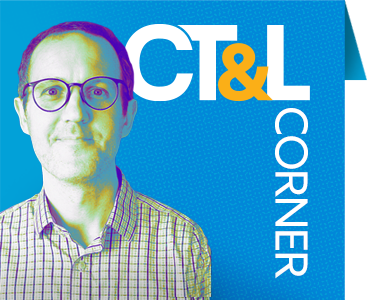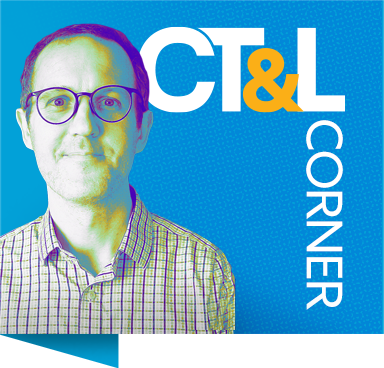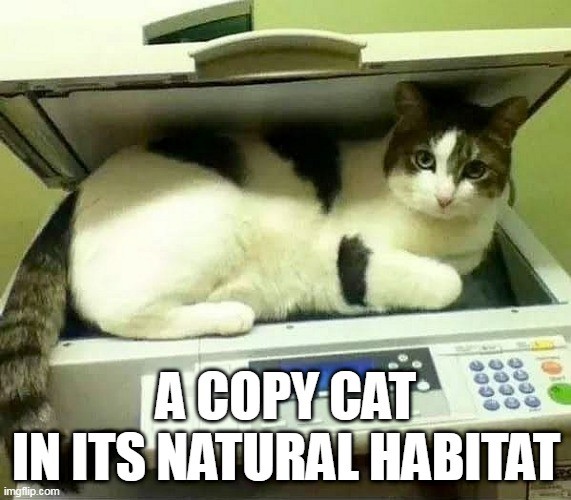Copycat isn’t usually meant as a compliment. In the same vein, many of us are familiar with the quote: ‘Imitation is the sincerest form of flattery’ (usually attributed to Oscar Wilde), but fewer of us may be familiar with the whole quote: ‘Imitation is the sincerest form of flattery that mediocrity can pay to greatness.’ (OUCH). In academic settings, these ideas are contained in the concept of plagiarism, attempting to pass off someone’s work as our own. The value of originality is so ingrained that there is such a thing as self-plagiarism, passing off previous work as original/new.
At the same time, there is a history of copying in visual art education. Making a copy was seen as part of the learning process: it requires the ability to recreate and the ability to make sense of what the original artist did (reverse-engineering their process). By copying, we internalize a way of making art, requiring some understanding of the physical processes by which it was made. This makes a lot of sense in tangible mediums like drawing, painting, and sculpture (though I do wonder about the role of copying in digital imagery). With this history in mind, how do we make sense of a disciplinary history of copying in the era of creativity, originality, and generative AI?
Is copying a detour on the way to originality?
The historical importance of copying brings up questions about the aims and methods of how we teach and learn art, design, and other problem-solving approaches. There are different versions of a similar quote on knowing the rules in order to break them, but they seem to imply that there are standards and/or traditions that we need to internalize and demonstrate before we strike out on our own in any meaningful way (which is its own conversation … for another day). This brings up questions about the role of examples in learning to make art.
As a music student, I was sometimes dissuaded from listening to recordings of pieces that I was learning for fear that I would attempt to imitate said recordings. This is a primary fear that teachers have: students will copy (rather than synthesize). In engineering education, studies have suggested that, yes, when shown just one example, students will apply its insights and/or design to their own work. Yet, when shown multiple, divergent solutions to the same challenge, students can begin to identify the different approaches and synthesize their respective insights. In other words, the practice of copying might limit our range, but it can be an in-depth study in making sense of how a work is made. There are different possible purposes: on the one hand, we can gain exposure to a range of approaches to the same artistic ‘problem,’ or we can focus on one particular ‘solution’ (I understand art is not a ‘problem’ like in math, so just indulge me).
Copying as a learning process
What’s more, engaging with the idea of copying opens up so many other possible discussions. It’s an opportunity to talk about what constitutes an intentional practice like copying for practice from plagiarism. Reflection can be as much a part of the assignment as the insistence of making an exact replica. In an age where technology can create effective dupes (hello, Open AI Ghibli Knockoffs), one way to maintain the value of copying is to leverage the learning that occurs around the copying. It may mean balancing the emphasis on technical recreation of the original with questions about what students are learning and how they might apply the techniques or imagery to their own work. If this is something you’ve done, I’d love to hear about it!
Copying can also be indirect. Working within a particular style (an homage) is a great example of the creativity of limits. A favorite podcast of mine is NPR’s Piano Puzzler (I’m a nerd, guilty as charged). On the show, composer Bruce Adolphe takes a popular tune and sets in the style of a classical composer (sometimes even using the texture from an existing work): you might have “Oh, What a Beautiful Morning” from Rodgers and Hammersteins’ Oklahoma set in Beethoven’s Moonlight Sonata, or a song by the Beatles in the style of Bach or Mozart. This may be the kind of ‘work’ that AI can do well, but, for students, it can be a great exercise with clear boundaries (it might even be fun).
Expanding our sense of what art can be
We’ve discussed the understandable fear of examples stultifying our students’ creativity. We’ve considered the possibilities of homage, of trying on different styles to see what we can gather… But how and why might this yield benefits? A pair of researchers from Japan have explored this question and have some ideas. One possible explanation is that with copying (or prolonged viewing of) an unfamiliar work, especially one in a different style than one is used to, may have meant that “… participants’ cognitive constraints became relaxed, and new perspectives were formed from copying another’s artwork…” (Okada & Ishibashi, 2017). Our ideas about what art is (or isn’t) expand, and we’re open to new ideas. Yet, as John Dewey famously said, “We don’t learn from experience. We learn from reflecting on experience.” Copying provides us with many opportunities to reflect on what we’ve learned, and that can indeed be a valuable experience.



